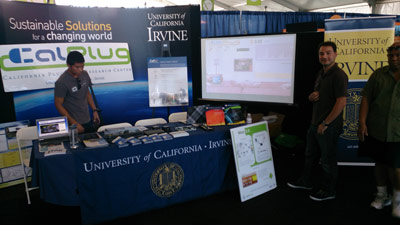 CalPlug presented its latest progress in energy efficiency research, representing UCI at the Solar Decathlon this past October. The Set Top Box (STB) project was on display, which is focused on developing a prototype of next-generation energy-efficient set top boxes. The main objective of the project is to demonstrate a “light sleep” enabled STB platform in a laboratory environment, exploring both hardware and software solutions in order to retrofit other STB devices already in use with the “light sleep” functionality. CalPlug also demonstrated the virtual version of the Wall of Power (WoP), which is designed to highlight energy usage and cost associated with using common household electronic devices. The WoP also aims to present the information it displays in an easily understood manner through an interactive interface. Overall, a large audience showed interest in the demonstrations and information presented at the CalPlug booth.
CalPlug presented its latest progress in energy efficiency research, representing UCI at the Solar Decathlon this past October. The Set Top Box (STB) project was on display, which is focused on developing a prototype of next-generation energy-efficient set top boxes. The main objective of the project is to demonstrate a “light sleep” enabled STB platform in a laboratory environment, exploring both hardware and software solutions in order to retrofit other STB devices already in use with the “light sleep” functionality. CalPlug also demonstrated the virtual version of the Wall of Power (WoP), which is designed to highlight energy usage and cost associated with using common household electronic devices. The WoP also aims to present the information it displays in an easily understood manner through an interactive interface. Overall, a large audience showed interest in the demonstrations and information presented at the CalPlug booth.
Going forward, CalPlug is a component of UCI’s Team Orange, applying to be a part of the 2015 Solar Decathalon. The team’s project, known as Casa Del Sol, aims to adhere to the latest zero-net energy standards using the latest energy efficient technology, educating both students and the general public on the latest innovations in green building.
Casa Del Sol is inspired by the California state flower, a drought-resistent, sun-embracing poppy. Employing biophilic design methods, the Spanish-style home makes use of a synthesis of green building best practices. Using adaptive technological innovation, the home will respond to, and eventually predict, user’s behavior as s/he occupies it. Integration of a 3D- printer allows residents to maintain, create and recycle plastic features within the home, pulling from a digital database. Energy use is managed by our smart-grid integrated Building Adaptive Smart-Home System and Nano-grid. The well-insulated home makes use of natural ventilation, passive solar techniques and an energy recovery ventilator to minimize power demand from our grid-tied solar PV panels. A ductless mini-split heat pump provides a mechanical back for our HVAC. Rainwater catchment and other water reduction techniques make this a drought-resistant home.
This project will become one of the first intelligent ZNE houses that are fully integrated with the future smart-grid. The unique autonomous, life-mimicking design brings the already stringent living building challenge to the next level. We’ll explore to what percentage a commercially viable house can be manufactured with 3D printers by experimenting with interior, exterior components as well as furniture. CDS is also an energy efficiency technology test bed for the latest research results in architecture, energy efficiency and artificial intelligence.
